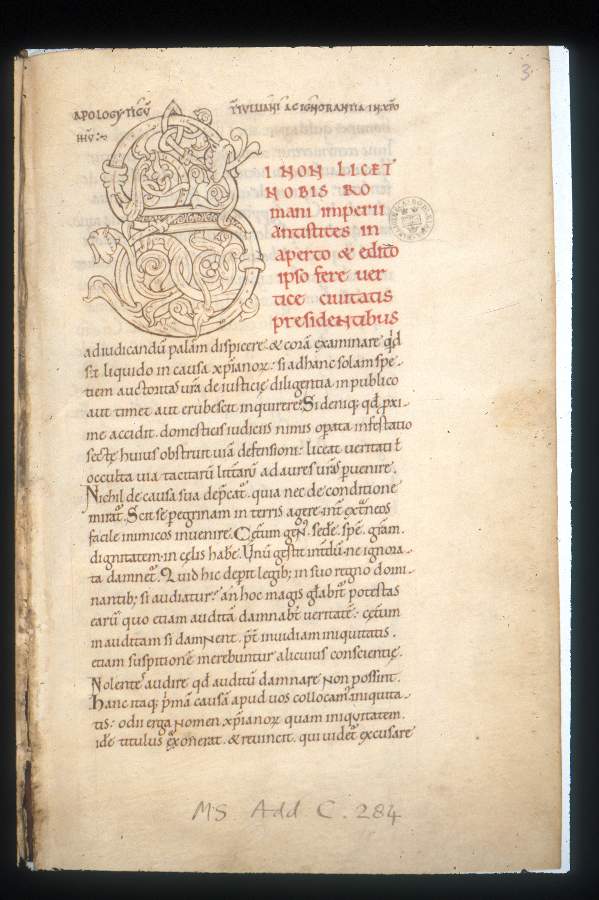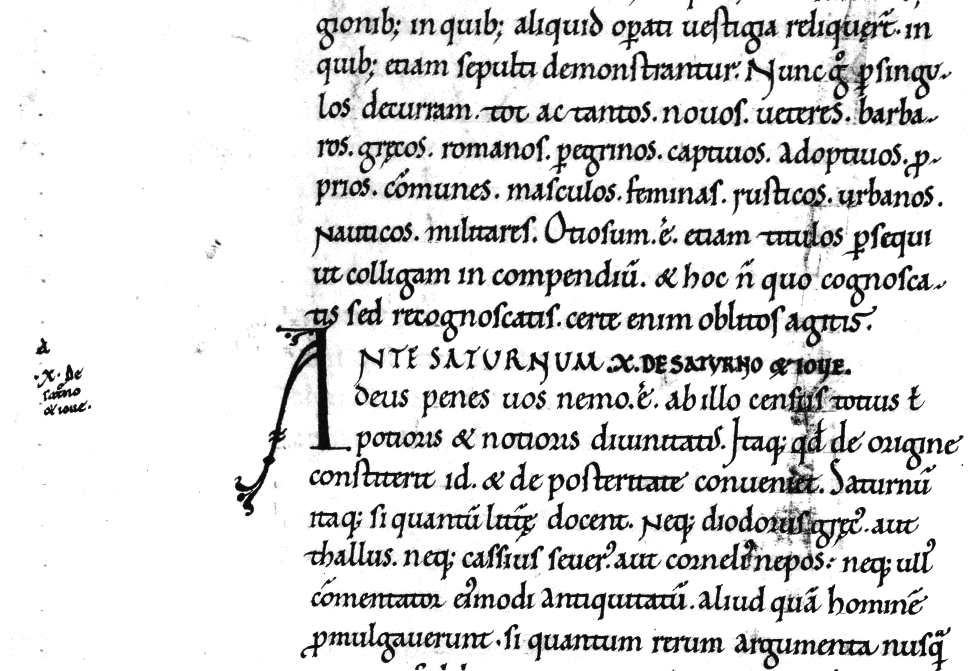

In Oxford, in Duke Humphrey's Library in the Bodleian Library, MS. Additional C 284. 11th century. Contains only the Apologeticum. Different arrangement of chapters. Parchment.
Folio 3:

Hoppe states (CSEL 40) that it was once known as Codex Maffeianus, as it came to Britain from the library of Maffeo of Verona (cf. Van der Vliet I. I. 53) and that the date was discussed by Van der Vliet in Mnemosyne XVIII (1890), p.52-3, but 'Nicholson' disagrees with it.
Inspected 20th August 1999. All details on this page by me, except the catalogue entry and quotations.
From Gullick 1: On p.72-3
The initial style of B.II.17 is found in another manuscript in which a few initials and some of the titles were executed by the rubricator of B.II.17. This manuscript, Bodl. Add.c.284 (Tertullian, Apologeticum, unknown origin), was also partly written by the Carilef Bible scribe.49 If it had been finished as it was begun it would have been a very pretty manuscript. The Carilef Bible scribe wrote the first two quires and the first page of the third (fig.14). The opening initial and title are by a hand or hands I have not noticed elsewhere. (Pächt and Alexander associate the handsome initial with Jumièges.) In the first quire many of the capitals were touched with color, and I suspect that the scribe might have executed the modestly decorated initials. A second, less good hand, a scribe not noticed elsewhere, wrote the rest of the manuscript.50 Three titles and initials were the work of the rubricator of B.II.17 (fig.14),51 and the initials in the rest of the manuscript were either never inserted or were added by a crude hand otherwise unknown.
The Tertullian is tantalizing because the author was rare, especially in England, and the inclusion of Tertullianus in William's gift to Durham is striking. However the presence of the Carilef Bible scribe in the manuscript does not help to tie Add.c.284 to Durham. Late medieval Durham book catalogues list a Tertullian cum excerptis canonum; but the words of the second folio (genitus eloquencia) are not found in the Apologeticum, and they also seem unlikely to be from a canonical collection.52 The manuscript's history does not shed more light: Add.c.284 is first recorded in Italy in the fifteenth century and its earliest recorded presence in England is during the eighteenth.53 The manuscript cannot be ascribed to Durham, but its recent ascription to Canterbury is puzzling.54
The footnotes from this text:
49. Ker, English manuscripts, p.24 n.2 3, Pächt and Alexander (note 17 above) I, no. 443.
50. Scribe A ( = Carilef Bible scribe ) wrote ff. 2-18, and B wrote ff. 18v-41v. Another hand appears to have corrected occasionally and written the marginal instructions with the copy for the titles throughout.
51. On ff. 12v, 15, and 17v. The display letters of the incipit page in Durham B.II.17 and the three initials in Add.c.284, with thin stems and exaggerated horizontal serifs, and a profusion of small dots, are quite like the display letters in Bodl. Bodley 717 (Jerome, Exeter, probably made at Jumièges s.xi ex.). Although there are some differences between the letters and their arrangement in the manuscripts, I think the similarities are striking although I do not wish to imply a common origin but rather a common aesthetic. The titles in Bodley 717 are almost certainly the work of Hugo pictor; see A.C.de la Mare in Trésors des Abbayes Normandes (note 25 above), no. 45, and for reproductions see N. Gray, A History of Lettering, (Oxford 1986), fig. 119, and C. de Hamel, A History of Illuminated Manuscripts (Oxford 1986), fig. 81.
See also the similar display letters in the title in a manuscript possibly made at Préaux, Tours, Bibliothèque municipale 98, for which see Avril, "Notes sur quelques manuscrits Bénédictins normands" (note 24 above), p. 236 with pl.52. Catalogi Veteres Librorum Ecclesiae Cathedralis Dunelmensis, Surtees Society 7 (1838), 31 and 109. (I owe the observation that the words of the second folio are unlikely to be from a canonical collection to Alan Piper.) For the circulation of Tertullian in England, see R.M.Thomson, William of Malmesbury (Woodbridge, Suffolk 1987), p.42.
53. J. Ruysschaert, "Recherches des deux bibliothèques romaines Maffei des XVe et XVIe siècles," La Bibliofilia 60 (1958) 352, no. 37; Summary Catalogue of Western Manuscripts in the Bodleian Library 5 (Oxford 1905), no.29638.
54. Ker, MLGB, Supplement, lists Add.c.284 under Christ Church Canterbury with a query. According to his sigla Ker included the manuscript for its script and content. Unfortunately the card for the manuscript, possibly with some explanatory note or reference, was not found by ANdrew Watson when he transferred Ker's cards for the Supplement to the Bodleian Library. I think the ascription should be treated cautiously if not rejected, for at present there is nothing I can see linking the manuscript to Canterbury. (I am grateful to Andrew Watson for discussing the matter of the card with me).
The plate:
fig. 14.: f.12v (detail, actual size). Text scribe: The Carilef Bible scribe. Rubricator: The initial A and the title were made by the same hand responsible for the initials and the titles in B.II.17, figs. 10-13.

Gullick suggests that the Carilef Bible scribe was based at Bayeux.
Catalogue Entry :
From Madan2, A Summary Catalogue of Western Manuscripts in the Bodleian Library at Oxford2, Vol. III, Oxford (1895), p.662
29638. In Latin, on parchment : written about A.D. 1100: 11 7/8 x 7¾ in., i+44 leaves : with illuminated capitals, &c. : binding, as no. 29637. (Which reads 'red russia with gold ornament, 18th century English work, worn'.)
'Apologyticum Tertulliani ac ignorantia in Christo Ihesu,' the Apologeticus adversus gentes.
'Leigh's Auction. Dr. Askews manuscripts [lot 531] £1 2s. M: Wodhull Mar: 15th 1785': the date 'Oct. 24th 1810' is on fol. 42. Bought as no. 29616 (lot 2511) on Jan. 20, 1886 for £12 10s.
[I should attribute the writing (Germanic?) to the early 12th cent. The hand changes on f. 18v. Note fine pen-and-ink interlaced S on f. 3; on and after f. 4v, use of several colours in the same chapter-heading, and in ornamenting capitals in the text; on and after f. 18, singular red-green-and-white initials; and remarkable A's on ff. 28, 33v. E.W.B.N]
Now MS. Add.C.284
From the Bodleian online catalogue of additional mss:
Shelfmark MS. Add. C. 284 Summary Catalogue no. 29638 Summary of contents Tertullian, Apologeticum. Language Latin Origin French, Normandy Date 11th century, end Material parchment Decoration Fine initial. Related to the Jumièges style. (P&A i. 443, pl. XXXVI) Images Catalogue image Vol. 5, p. 662 Manuscript image fol. 3r Initial 'S' in brown ink outline drawing with leaf-curl interlace. Bibliography 1990 Michael Gullick, 'The scribe of the Carilef Bible a new look at some late-eleventh-century Durham Cathedral manuscripts', in Medieval Book Production: Assessing the Evidence, ed. L. L. Brownrigg (Proceedings of the Second Conference of the Seminar in the History of the Book to 1500, July 1988), Los Altos Hills (CA): Anderson-Lovelace, 1990, pp. 72 fig. 14 [fol. 12v], 73, 74 (table), 80 n. 51
SCWMSS archive: = REFS. LXXXVI.19Michael Gullick, 'The scribe of the Carilef Bible: a new look at some late-eleventh-century Durham Cathedral manuscripts', in Medieval Book Production: Assessing the Evidence. Proceedings of the Second Conference of the Seminar in the History of the Book to 1500, Oxford, July 1988, ed. Linda L. Brownrigg, Los Altos Hills, Calif.: Anderson-Lovelace, 1990, pp. 61-83
Microfilms Available? Yes - I've got one. I've also got a couple of 35 mm slides made of particular pages - f3r and f41v and a 'general view of the MS' - so you can get those too - details when they arrive. The best alternative is to purchase unmounted 35mm strip-film which is cheaper, but of course I didn't find out about that until later.
Binding : Stamped with gold, worn. 6 sewing points.
Spine : Illegible paper label.
End-leaves : Coloured endpapers.
Material details : Page size - 28.5 x 18.5 cms; text - 21.5 x 11 cms. 31 lines per page. On both sides of the page are two tramlines. Hard ruled. Beautiful clear Carolingian minuscule. The ink has browned. Tiny corrections in a permanent black ink. Simple colouring - red, green, blue initials.
Ultra-violet : Examined, but nothing visible.
Other Notes : In 47 chapters, and chapter divisions and titles different to any others I've seen so far.
Bibliography :
These are the most recent index cards held by the Bodleian for this MS, accessible on request. I must go and ask to see these - there are more for the older literature.
1. Michael Gullick1, 'The scribe of the Carilef Bible: a new look at some
late-eleventh-century Durham Cathedral manuscripts', in "Medieval book production, assessing the evidence: proceedings of the Second Conference of
The Seminar in the History of the Book to 1500, Oxford, July 1988" ed. Linda L. Brownrigg (Los Altos Hills, CA, 1990),
pp. 61-83 Checked
2. N. R. Ker3, English manuscripts in the century after the Norman
Conquest (Oxford, 1960), p.24 n.2. Checked
3. Rodney M. Thomson, "William of Malmesbury" (Woodbridge, 1987).
Checked
Page by page :
| Folio | Notes |
| 0v | At the top of the page:
Further down:
And below in purple crayon(!)
|
| 1r | At the left-top:
At right top:
At the centre bottom:
|
| 2 | Blank, but hard-point ruled and pricked |
| 3r | At top:
The S is a large initial running down every line until 'adiu...'. The first two lines are capitals. At the bottom of the page:
|
| 12r | Chapter 9 has no initial, no coloured chapter no or heading, and no illumination on the page. |
| 12v | (See image above) |
| ch. 23 | No initial, chapter no, or heading, but in black in extreme margin are details of no and title. |
| 27-28 | This bifolium is loose. |
| ch's. 44, 45, 46, 47 | No initial, chapter no, or heading, but in black in extreme margin are details of no and title. |
| 41v | At bottom:
|
| 42-3 | End leaves (blank) |
| 44 | Card |
Bibliography
1. Gullick (Michael), The Scribe of the Carilef Bible: A New Loook at some Late-Eleventh-Century Durham Cathedral Manuscripts, pp.61-83 in Brownrigg (Linda L.)(ed.), Medieval Book Production: Assessing the Evidence, Proceedings of the Second Conference of The Seminar in the History of the Book to 1500 Oxford July 1988, Los Altos, California (1990). Checked
2. Madan (Falconer), A Summary Catalogue of Western Manuscripts in the Bodleian Library at Oxford, Vol. III, Oxford (1895), p.662 Checked
3. N. R. Ker, English manuscripts in the century after the Norman Conquest (Oxford, 1960), p.24 n.2 reads:
Bodleian, Add. C. 284, Tertullian, seems to be partly (fos. 1-18) in the same hand as the Carilef Bible. There is no evidence that it was in English before the eighteenth century.
The point made is that both were from a continental
scriptorium. pp.23-24 discuss the supply of books written in a
Norman hand, doubtless from Norman scriptoria, for the Cathedrals of Exeter and
Durham supplied by their first Norman Bishops in order to give the libraries the
standard Benedictine texts. Checked

This page has been online since 11th December 1999.